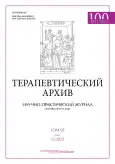Предиктивная возможность однонуклеотидных полиморфизмов Cys112Arg гена аполипопротеина Е в оценке риска развития немедленных и ранних посттравматических судорог
- Авторы: Крюкова К.К.1, Александрова Е.В.2, Воскресенская О.Н.1, Подлепич В.В.2, Кравчук А.Д.2, Рыткин Э.И.3, Латышев Я.А.2, Кудлай Д.А.1, Сологова С.С.1, Албагачиев С.А.1, Мандрик М.А.1
-
Учреждения:
- ФГАОУ ВО «Первый Московский государственный медицинский университет им. И.М. Сеченова» Минздрава России (Сеченовский Университет)
- ФГАУ «Национальный медицинский исследовательский центр нейрохирургии им. акад. Н.Н. Бурденко» Минздрава России
- Северно-Западный университет
- Выпуск: Том 95, № 12 (2023)
- Страницы: 1128-1132
- Раздел: Оригинальные статьи
- URL: https://journals.rcsi.science/0040-3660/article/view/258740
- DOI: https://doi.org/10.26442/00403660.2023.12.202492
- ID: 258740
Цитировать
Полный текст
Аннотация
Настоящее исследование направлено на изучение одного из последствий черепно-мозговой травмы (ЧМТ) – эпилептических приступов. Немедленные и ранние посттравматические судороги, а также поздние посттравматические эпилептические приступы или посттравматическая эпилепсия могут иметь различные патогенетические основания. Известны следующие ключевые риск-факторы, ассоциированные с развитием посттравматической эпилепсии: продолжительность потери сознания, огнестрельные ранения, внутричерепное кровоизлияние, диффузное аксональное повреждение, продолжительная (более 3 дней) посттравматическая амнезия, острая субдуральная гематома с хирургической эвакуацией, немедленные и ранние посттравматические эпилептические приступы, перелом костей черепа. Роли генетических факторов в развитии посттравматических судорог уделяется мало внимания ввиду сложности, многокомпонентности причинно-следственных механизмов. В настоящей работе приведена попытка изучения роли генетических факторов, имеющих влияние на развитие и выраженность эпилептических событий, на выборке пациентов с ЧМТ. В частности, мы исследовали роль однонуклеотидного полиморфизма Cys112Arg гена аполипопротеина E. Аполипопротеин E известен своей ролью в транспорте и метаболизме липидов, а следовательно, и развитии сердечно-сосудистых заболеваний, также связан с болезнью Альцгеймера и относительно недавно стал предметом изучения в контексте ассоциации с эпилепсией. В исследовании показана связь между указанным полиморфизмом и риском развития немедленных и ранних эпилептических приступов у пациентов с тяжелой ЧМТ.
Ключевые слова
Полный текст
Открыть статью на сайте журналаОб авторах
Ксения Константиновна Крюкова
ФГАОУ ВО «Первый Московский государственный медицинский университет им. И.М. Сеченова» Минздрава России (Сеченовский Университет)
Email: ks.k.kryukova@gmail.com
ORCID iD: 0000-0001-6714-9780
аспирант каф. нервных болезней и нейрохирургии
Россия, МоскваЕвгения Владимировна Александрова
ФГАУ «Национальный медицинский исследовательский центр нейрохирургии им. акад. Н.Н. Бурденко» Минздрава России
Email: ks.k.kryukova@gmail.com
ORCID iD: 0000-0001-5327-314X
канд. мед. наук, врач-невролог
Россия, МоскваОльга Николаевна Воскресенская
ФГАОУ ВО «Первый Московский государственный медицинский университет им. И.М. Сеченова» Минздрава России (Сеченовский Университет)
Email: ks.k.kryukova@gmail.com
ORCID iD: 0000-0002-7330-633X
д-р мед. наук, проф. каф. нервных болезней и нейрохирургии
Россия, МоскваВиталий Вячеславович Подлепич
ФГАУ «Национальный медицинский исследовательский центр нейрохирургии им. акад. Н.Н. Бурденко» Минздрава России
Email: ks.k.kryukova@gmail.com
ORCID iD: 0000-0002-3424-3815
канд. мед. наук, врач-реаниматолог
Россия, МоскваАлександр Дмитриевич Кравчук
ФГАУ «Национальный медицинский исследовательский центр нейрохирургии им. акад. Н.Н. Бурденко» Минздрава России
Автор, ответственный за переписку.
Email: ks.k.kryukova@gmail.com
ORCID iD: 0000-0002-3112-8256
д-р мед. наук, врач-нейрохирург, зав. отд-нием черепно-мозговой травмы
Россия, МоскваЭрик Игоревич Рыткин
Северно-Западный университет
Email: ks.k.kryukova@gmail.com
ORCID iD: 0000-0003-2511-0655
докторант, науч. сотр.
США, ЧикагоЯрослав Александрович Латышев
ФГАУ «Национальный медицинский исследовательский центр нейрохирургии им. акад. Н.Н. Бурденко» Минздрава России
Email: ks.k.kryukova@gmail.com
ORCID iD: 0000-0002-7125-5962
канд. мед. наук, врач-нейрохирург
Россия, МоскваДмитрий Анатольевич Кудлай
ФГАОУ ВО «Первый Московский государственный медицинский университет им. И.М. Сеченова» Минздрава России (Сеченовский Университет)
Email: ks.k.kryukova@gmail.com
ORCID iD: 0000-0003-1878-4467
чл.-кор. РАН, д-р мед. наук, проф. каф. фармакологии Института фармации им. А.П. Нелюбина
Россия, МоскваСусанна Сергеевна Сологова
ФГАОУ ВО «Первый Московский государственный медицинский университет им. И.М. Сеченова» Минздрава России (Сеченовский Университет)
Email: ks.k.kryukova@gmail.com
ORCID iD: 0000-0002-8526-7147
канд. биол. наук, доц., зав. учебной частью каф. фармакологии Института фармации им. А.П. Нелюбина
Россия, МоскваСабр Алиханович Албагачиев
ФГАОУ ВО «Первый Московский государственный медицинский университет им. И.М. Сеченова» Минздрава России (Сеченовский Университет)
Email: ks.k.kryukova@gmail.com
ORCID iD: 0009-0003-5489-7001
ординатор каф. фармацевтической технологии Института фармации им А.П. Нелюбина
Россия, МоскваМарк Александрович Мандрик
ФГАОУ ВО «Первый Московский государственный медицинский университет им. И.М. Сеченова» Минздрава России (Сеченовский Университет)
Email: ks.k.kryukova@gmail.com
ORCID iD: 0000-0002-3558-9615
ассистент каф. фармацевтической технологии Института фармации им. А.П. Нелюбина
Россия, МоскваСписок литературы
- Hyder AA, Wunderlich CA, Puvanachandra P, et al. The impact of traumatic brain injuries: A global perspective. NeuroRehabilitation. 2007;22:341-53. doi: 10.3233/NRE-2007-22502
- Salazar AM, Grafman J. Role of Antiseizure Prophylaxis Following Head Injury. Post-traumatic epilepsy: clinical clues to pathogenesis and paths to prevention. Handb Clin Neurol. 2015;128:525-38. doi: 10.1016/B978-0-444-63521-1.00033-9
- Agrawal A, Timothy J, Pandit L, Manju M. Post-traumatic epilepsy: An overview. Clin Neurol Eurosurg. 2006;108:433-9. doi: 10.1016/j.clineuro.2005.09.001
- Cecile JW, Ioannidis JPA, Bedrosian S, et al. Strengthening the reporting of genetic risk prediction studies (GRIPS): explanation and elaboration: grips statement: explanation and elaboration. Eur J Clin Invest. 201;141:1010-35. doi: 10.1111/j.1365-2362.2011.02493.x
- Boone DR, Weisz HA, Willey HE, et al. Traumatic brain injury induces long-lasting changes in immune and regenerative signaling. PloS One. 2019;14. doi: 10.1371/journal.pone.0214741
- Jarrahi A, Braun M, Ahluwalia M, et al. Revisiting Traumatic Brain Injury: From Molecular Mechanisms to Therapeutic Interventions. Biomedicines. 2020;8:389. doi: 10.3390/biomedicines8100389
- Werner C, Engelhard K. Pathophysiology of traumatic brain injury. Br J Anaesth. 2007;99:4-9. doi: 10.1093/bja/aem131
- Vespa PM, Nuwer MR, Nenov V, et al. Increased incidence and impact of nonconvulsive and convulsive seizures after traumatic brain injury as detected by continuous electroencephalographic monitoring. J Neurosurg. 1999;91:750-60. doi: 10.3171/jns.1999.91.5.0750
- Zimmermann LL, Diaz-Arrastia R, Vespa PM. Seizures and the Role of Anticonvulsants After 15. Traumatic Brain Injury. Neurosurg Clin N Am. 2016;27:499-508. doi: 10.1016/j.nec.2016.06.001
- Misra S, Quinn TJ, Falcone GJ, et al. Impact of genetic polymorphisms on the risk of epilepsy amongst patients with acute brain injury: A systematic review. Eur J Neurol. 2023;30:1791-800. doi: 10.1111/ene.15777
- Lamoureux L, Marottoli FM, Tseng KY, Tai LM. APOE4 Promotes Tonic-Clonic Seizures, an Effect Modified by Familial Alzheimer’s Disease Mutations. Front Cell Dev Biol. 2021;9:656521. doi: 10.3389/fcell.2021.656521
- Raulin AC, Doss SV, Trottier ZA, et al. ApoE in Alzheimer’s disease: pathophysiology and therapeutic strategies. Mol Neurodegener. 2022;17:72. doi: 10.1186/s13024-022-00574-4
- Miller MA, Conley Y, Scanlon JM, et al. APOE genetic associations with seizure development after severe traumatic brain injury. Brain Inj. 2010;24:1468-77. doi: 10.3109/02699052.2010.520299
- Клинические рекомендации «Очаговая травма головного мозга» (утв. Минздравом России). М., 2022 [Klinicheskie rekomendatsii “Ochagovaia travma golovnogo mozga (utv. Minzdravom Rossii). Moscow, 2022 (in Russian)].
Дополнительные файлы








